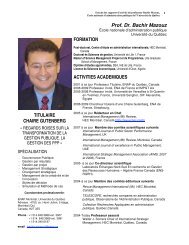Why do firms both make and buy? An investigation of concurrent ...
Why do firms both make and buy? An investigation of concurrent ...
Why do firms both make and buy? An investigation of concurrent ...
You also want an ePaper? Increase the reach of your titles
YUMPU automatically turns print PDFs into web optimized ePapers that Google loves.
292 A. Parmigiani<br />
In other words, there will be a continuous <strong>and</strong><br />
negative relationship between the suppliers’ scope<br />
economies <strong>and</strong> the firm’s internal production.<br />
However, the firm considers <strong>both</strong> its <strong>and</strong> its supplier’s<br />
scope economies in sourcing decisions. The<br />
firm <strong>and</strong> supplier may experience different levels<br />
<strong>of</strong> scope economies, since these depend upon the<br />
other goods each one produces. They may use dissimilar<br />
production processes <strong>and</strong> thus each has a<br />
different type <strong>of</strong> excess sharable input that they<br />
wish to more fully utilize (Barney, 1991; Helfat<br />
<strong>and</strong> Eisenhardt, 2004). For example, a supplier<br />
may have excess capacity on a particular machine<br />
while the firm may have slack internal engineering<br />
resources, <strong>both</strong> <strong>of</strong> which could be better utilized by<br />
the firm <strong>and</strong> the supplier producing the good. In<br />
this way, scope economies can provide symmetric<br />
incentives for the firm <strong>and</strong> supplier. Therefore,<br />
if <strong>both</strong> the firm <strong>and</strong> the supplier could reduce<br />
their production costs through scope economies,<br />
the firm would be motivated to <strong>make</strong> <strong>and</strong> to <strong>buy</strong><br />
in order to enjoy <strong>both</strong> lower internal costs <strong>and</strong> relatively<br />
low supplier prices. This leads to the next<br />
hypothesis:<br />
Hypothesis 4neo: The greater scope economies<br />
for <strong>both</strong> the firm <strong>and</strong> its suppliers to produce the<br />
good, the more likely the firm will <strong>concurrent</strong>ly<br />
source.<br />
Capabilities <strong>and</strong> <strong>concurrent</strong> sourcing<br />
The capabilities view (e.g., Teece, Pisano, <strong>and</strong><br />
Shuen, 1997; Eisenhardt <strong>and</strong> Martin, 2000), incorporating<br />
the resource- <strong>and</strong> knowledge-based views<br />
<strong>of</strong> the firm, complements the above two literatures<br />
by considering how attributes <strong>of</strong> the firm <strong>and</strong> its<br />
suppliers affect the sourcing decision. A firm will<br />
produce goods that are close to its area <strong>of</strong> expertise,<br />
core to its business, <strong>and</strong> related to items it<br />
already produces, as it uses past experience <strong>and</strong><br />
resources as ‘stepping stones’ into related areas<br />
(Wernerfelt, 1984; Barney, 1986; Prahalad <strong>and</strong><br />
Hamel, 1990). This expertise is broader <strong>and</strong> deeper<br />
than just the sum <strong>of</strong> the firm’s prior experience in<br />
production as it incorporates its underst<strong>and</strong>ing <strong>of</strong><br />
the base technology <strong>and</strong> the firm’s related skills.<br />
Every firm is different, so some goods will be a<br />
better fit with its resource or knowledge base than<br />
others. If the good is a poor fit, it will be more<br />
efficient to outsource (Rubin, 1973; Kogut <strong>and</strong><br />
Z<strong>and</strong>er, 1992; Conner <strong>and</strong> Prahalad, 1996; Grant,<br />
1996). Suppliers’ costs will depend upon their relative<br />
expertise, resources, <strong>and</strong> capabilities <strong>and</strong> thus<br />
each individual supplier will <strong>of</strong>fer a somewhat different<br />
blend <strong>of</strong> price, delivery, quality, <strong>and</strong> other<br />
attributes for the sourcing firm to consider (Penrose,<br />
1959; Barney, 1991). This suggests a continuum<br />
such that the greater a firm’s expertise about<br />
a good, the greater its degree <strong>of</strong> internalization<br />
<strong>and</strong> the greater the supplier’s expertise, the greater<br />
the degree <strong>of</strong> outsourcing. If either the firm or the<br />
supplier has relatively greater expertise, then internalization<br />
or outsourcing, respectively, will result<br />
(Jacobides, 2004). However, if <strong>both</strong> the firm <strong>and</strong><br />
the supplier have significant expertise, the firm will<br />
be motivated <strong>both</strong> to <strong>make</strong>, to take advantage <strong>of</strong><br />
its own expertise, <strong>and</strong> to <strong>buy</strong>, to learn from suppliers.<br />
This case is analogous to the neoclassical<br />
case <strong>of</strong> combined scope economies with <strong>concurrent</strong><br />
sourcing being a logical choice, since the firm<br />
is motivated to <strong>both</strong> <strong>make</strong> <strong>and</strong> <strong>buy</strong>. This logic supports<br />
the next hypothesis:<br />
Hypothesis 5cap: The greater the expertise <strong>of</strong><br />
<strong>both</strong> the firm <strong>and</strong> its suppliers, the more likely<br />
the firm will <strong>concurrent</strong>ly source.<br />
When a firm <strong>concurrent</strong>ly sources, learning will<br />
be enhanced, since it gains <strong>both</strong> the deep tacit<br />
knowledge <strong>of</strong> internal production <strong>and</strong> the broader,<br />
more diverse underst<strong>and</strong>ing from external supply<br />
relationships. Making the good improves the firm’s<br />
underst<strong>and</strong>ing, since it gains a deeper tacit knowledge<br />
<strong>of</strong> the good <strong>and</strong> its processes (Kogut <strong>and</strong> Z<strong>and</strong>er,<br />
1992; Darr, Argote, <strong>and</strong> Epple, 1995; Grant,<br />
1996). The knowledge <strong>and</strong> skills the firm accumulates<br />
through this ‘learning by <strong>do</strong>ing’ cannot<br />
be replicated through outside supply relationships<br />
(Pisano, 1994). Buying the good provides vicarious<br />
learning from the outside suppliers who are connected<br />
through customer relationships to the firm’s<br />
competitors <strong>and</strong> to <strong>firms</strong> in other industries. Since<br />
suppliers may not necessarily provide their goods<br />
at lower prices, a key benefit <strong>of</strong> <strong>concurrent</strong> sourcing<br />
is the ‘net gain in the know-how <strong>and</strong> the trade<br />
connections’ (Adelman, 1949: 116). This sourcing<br />
mode allows the firm access to <strong>both</strong> external suppliers’<br />
research <strong>and</strong> technology developments <strong>and</strong><br />
to its own internal knowledge <strong>of</strong> the good <strong>and</strong> its<br />
related production processes (Porter, 1980; Harrigan,<br />
1984; Cassiman <strong>and</strong> Veugelers, 2006).<br />
Copyright © 2007 John Wiley & Sons, Ltd. Strat. Mgmt. J., 28: 285–311 (2007)<br />
DOI: 10.1002/smj





